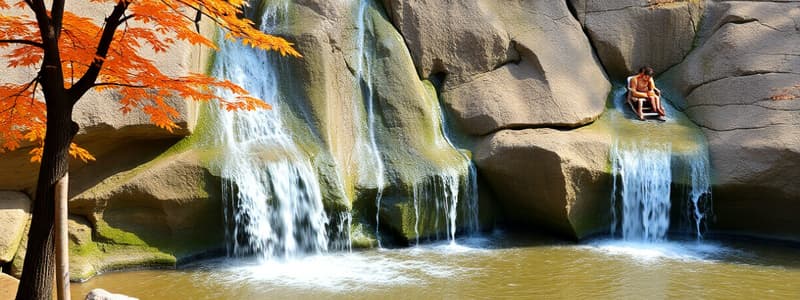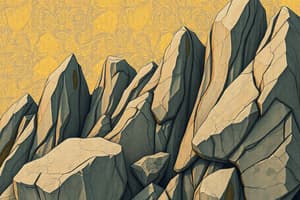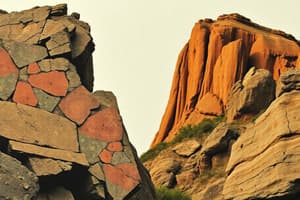Podcast
Questions and Answers
Which of Earth's layers is best described as a semi-liquid, facilitating the movement of tectonic plates?
Which of Earth's layers is best described as a semi-liquid, facilitating the movement of tectonic plates?
- Mantle (correct)
- Crust
- Outer Core
- Inner Core
Which process describes the breakdown of rock by physical, chemical, or biological means?
Which process describes the breakdown of rock by physical, chemical, or biological means?
- Metamorphism
- Sedimentation
- Erosion
- Weathering (correct)
What primary force drives the process of erosion?
What primary force drives the process of erosion?
- High Pressure
- Extreme Heat
- Wind and Water (correct)
- Chemical Reactions
Which is the best description of sedimentary rock formation?
Which is the best description of sedimentary rock formation?
What is the origin of igneous rocks?
What is the origin of igneous rocks?
What conditions are necessary for the formation of metamorphic rocks?
What conditions are necessary for the formation of metamorphic rocks?
Which term refers to layers within sedimentary rock?
Which term refers to layers within sedimentary rock?
What is the composition of Earth's inner core?
What is the composition of Earth's inner core?
What role does magma play in the rock cycle?
What role does magma play in the rock cycle?
What distinguishes extrusive igneous rocks from intrusive igneous rocks?
What distinguishes extrusive igneous rocks from intrusive igneous rocks?
How do changes in heat and pressure influence the formation of marble, slate, and schist?
How do changes in heat and pressure influence the formation of marble, slate, and schist?
Which is a key characteristic of sedimentary rocks that distinguishes them from other rock types?
Which is a key characteristic of sedimentary rocks that distinguishes them from other rock types?
How does the cooling rate of magma affect the crystal size in igneous rocks?
How does the cooling rate of magma affect the crystal size in igneous rocks?
Which of the following correctly sequences the steps involved in the formation of sedimentary rocks?
Which of the following correctly sequences the steps involved in the formation of sedimentary rocks?
What is the primary difference between the Earth's outer core and inner core?
What is the primary difference between the Earth's outer core and inner core?
Which set of processes best describes the rock cycle?
Which set of processes best describes the rock cycle?
Which of the following pairs of processes are most responsible for creating the rounded appearance of rocks in a riverbed?
Which of the following pairs of processes are most responsible for creating the rounded appearance of rocks in a riverbed?
How does burial, high temperature, and high pressure contribute to the rock cycle?
How does burial, high temperature, and high pressure contribute to the rock cycle?
Which of these statements accurately links a rock type with its formation environment?
Which of these statements accurately links a rock type with its formation environment?
What is the relationship between the rock cycle and the Earth's internal heat?
What is the relationship between the rock cycle and the Earth's internal heat?
Flashcards
Rock Cycle
Rock Cycle
Processes that lead a rock changing from one type to another.
Weathering
Weathering
The wearing down of a rock by physical, chemical, or biological processes.
Erosion
Erosion
Weathering of rock and its movement by water, ice, and wind.
Minerals
Minerals
Signup and view all the flashcards
Sedimentary Rocks
Sedimentary Rocks
Signup and view all the flashcards
Igneous Rocks
Igneous Rocks
Signup and view all the flashcards
Metamorphic Rocks
Metamorphic Rocks
Signup and view all the flashcards
Magma
Magma
Signup and view all the flashcards
Crust
Crust
Signup and view all the flashcards
Mantle
Mantle
Signup and view all the flashcards
Outer Core
Outer Core
Signup and view all the flashcards
Inner Core
Inner Core
Signup and view all the flashcards
Strata
Strata
Signup and view all the flashcards
Study Notes
- Earth structure is the study of the Earth.
Rock Cycle
- Processes that lead to a rock changing from one type to another.
- Includes: weathering and erosion, transportation and deposition, sedimentation, compaction, cementation, burial, high temperatures and pressures, melting, crystallization of magma and slow uplift to the surface.
Weathering
- The wearing down of a rock by physical, chemical, or biological processes.
Erosion
- Weathering of rock and its movement by water, ice, and wind.
Minerals
- Chemicals that a rock is made from.
Sedimentary Rocks
- Rocks formed from layers of sediment in time.
- More sediments add to layer with their own layers.
- Sedimentary rocks can contain fossils.
- Examples include: limestone, chalk, and sandstone.
Igneous Rocks
- Rocks formed from cooled magma, with the minerals arranged in crystals.
- Igneous rocks have varying sizes of crystals.
- When the magma has longer to cool, this forms rocks with larger crystals
- Examples include: granite, basalt, and obsidian.
Metamorphic Rocks
- Rocks made from existing rocks that are heated and withstand high pressure over long periods of time.
- Rocks that have changed due to changes in heat and pressure.
- When igneous or sedimentary rocks are heated or undergo high pressures, their structures change.
- Examples include: marble, slate, and schist.
Strata
- Another term for layers in a sedimentary rock.
Magma
- Molten rock.
The Layers of the Earth
- Crust is the outermost layer, it is thin and made out of sections called tectonic plates.
- Mantle is a semi liquid that causes the plates above to move due to convection currents.
- Outer core is a liquid layer made out of molten iron and other elements.
- Inner core is the inner most section, it is solid.
- Inner core is mainly made out of iron and nickel.
Igneous Rock Types
- Extrusive igneous rock type exists.
- Intrusive igneous rock type exists.
Studying That Suits You
Use AI to generate personalized quizzes and flashcards to suit your learning preferences.




